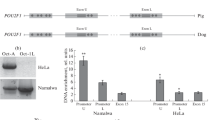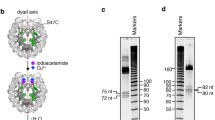Abstract
The Oct-1 transcription factor belongs to a family of highly conserved POU domain proteins that participate in the regulation of housekeeping and tissue-specific gene expression. Several isoforms of Oct-1 were described previously. We have found the new alternative promoter of Oct-1 gene and the corresponding mRNA Oct-1X. This mRNA encodes the alternative Oct-1 isoform, which has a truncated N-terminus compared to Oct-1A or Oct-1L isoforms. We explored the expression pattern of this isoform in human tissues and cell lines and demonstrated that it is ubiquitously expressed, but its expression strongly varies in different tissues. Using cotransfection and double luciferase assay, we have demonstrated that Oct-1X is the activator of housekeeping (histone H2B) and tissue-specific genes (B29) transcription.
Similar content being viewed by others
References
Sytina E.V., Pankratova E.V. 2003. Transcription factor Oct-1: Plasticity and multiplicity of functions. Mol. Biol. (Moscow). 37, 637–648.
Kang J., Shakya A., Tantin D. 2009. Stem cells, stress, metabolism and cancer: A drama in two Octs. Trends Bichem. Sci. 34, 491–500.
Zhao F.Q., Zheng Y., Dong B., Oka T. 2004. Cloning, genomic organization, expression, and effect on betacasein promoter activity of a novel isoform of the mouse Oct-1 transcription factor. Gene. 326, 175–187.
Stepchenko A.G. 1991. The nucleotide sequence of mouse OCT-1 cDNA. Nucleic Acids Res. 20, 1419.
Pankratova E.V., Deyev I.E., Zhenilo S.V., Polanovsky O.L. 2001. Tissue-specific isoforms of the ubiquitous transcription factor Oct-1. Mol. Genet. Genom. 266, 239–245.
Luo J., Roeder R.G. 1995. Cloning, functional characterization, and mechanism of action of the B-cell specific transcriptional co-activator OCA-B. Mol. Cell. Biol. 15, 4115–4124.
He X., Treacy M.N., Simmons D.M., Ingraham H.A., Swanson L.W., Rosenfeld M.G. 1989. Expression of a large family of POU-domain regulatory genes in mammalian brain development. Nature. 340, 35–42.
Kang J., Goodman B., Zheng Y., Tantin D. 2011. Dynamic regulation of Oct1 during mitosis by phosphorylation and ubiquitination. PloS ONE. 6(8), e23872.
Mancini M., Leo E., Aluigi M., Marcozzi C., Borsi E., Barbieri E., Santucci M.A. 2012. Gadd45a transcriptional induction elicited by the Aurora kinase inhibitor MK-0457 in Bcr-Abl-expressing cells is driven by Oct1 transcription factor. Leuk. Res. 36(8), 1028–1034.
Magne S., Caron S., Charon M., Rouyes M-C., DU. S. Anter-Fourt I. 2003. STAT5 and Oct-1 forms a stable complex that modulates Cyclin D1 expression. Mol. Cell Biol. 23(24), 8934–8945.
Zheng L., Roeder R.G., Luo Y. 2003. S phase activation of the histone H2B promoter by OCA-S, a coactivator complex that contains GAPDH as a key component. Cell. 114, 255–266.
Shakoori A.R., Hoessli D.C., Nasir-Ud-Din. 2012. Post-translational modifications in activation and inhibition of Oct-1-DNA binding complex in H2B and other diverse genes regulation: Prediction of interplay sites. J. Cell Biochem. 10, 1002/jcb.24382.
Pankratova E.V., Sytina E.V., Luchina N.N., Krivega I.V. 2003. The regulation of the oct-1 gene transcription is mediated by two promoters. Immunol. Lett. 88, 15–20.
Luchina N.N., Krivega I.V., Pankratova E.V. 2003. Human Oct-1 isoform has tissue-specific expression pattern similar to Oct-2. Immunol. Lett. 85, 237–241.
Pankratova E., Sytina E., Polanovsky O. 2006. Autoregulation of Oct-1 gene expression is mediated by two octa-sites in alternative promoter. Biochimie. 88, 1323–1329.
Deev I.E., Polianovsky O.L. 2004. oct-genes and Octproteins. Mol. Biol. (Moscow). 38(1), 48–55.
Pankratova E.V., Manuylova E.A., Stepchenko A.G. 2009. Transcription factor-binding sites responsible for NO-dependent repression of the histone H2B promoter. Mol. Biol. (Moscow). 43, 339–343.
Author information
Authors and Affiliations
Corresponding author
Additional information
Original Russian Text © I.D. Krylova, T.N. Portseva, S.G. Georgieva, A.G. Stepchenko, E.V. Pankratova, 2013, published in Molekulyarnaya Biologiya, 2013, Vol. 47, No. 4, pp. 634–641.
Rights and permissions
About this article
Cite this article
Krylova, I.D., Portseva, T.N., Georgieva, S.G. et al. New mRNA isoform of Oct-1 transcription factor is transcribed from alternative promoter. Mol Biol 47, 552–558 (2013). https://doi.org/10.1134/S0026893313040080
Received:
Accepted:
Published:
Issue Date:
DOI: https://doi.org/10.1134/S0026893313040080




